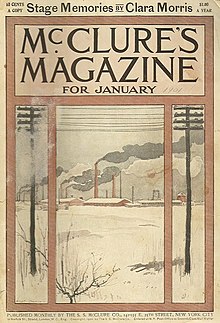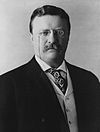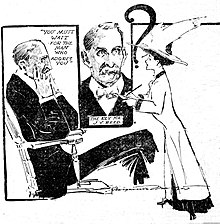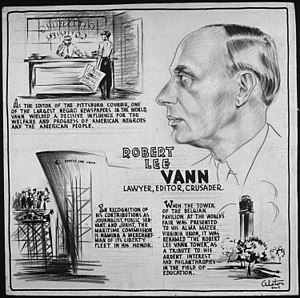McClure's (cover, January 1901) published many early muckraker articles.
The term muckraker was used in the Progressive Era
to characterize reform-minded American journalists who attacked
established institutions and leaders as corrupt. They typically had
large audiences in some popular magazines. In the US, the modern term is
investigative journalism—it
has different and more pejorative connotations in British English—and
investigative journalists in the US today are often informally called
"muckrakers".
The muckrakers played a highly visible role during the Progressive Era period, 1890s–1920s. Muckraking magazines—notably McClure's of the publisher S. S. McClure—took on corporate monopolies and political machines while trying to raise public awareness and anger at urban poverty, unsafe working conditions, prostitution, and child labor. Most of the muckrakers wrote nonfiction, but fictional exposes often had a major impact as well, such as those by Upton Sinclair.
In contemporary American use, the term describes either a
journalist who writes in the adversarial or alternative tradition, or a
non-journalist whose purpose in publication is to advocate reform and
change. Investigative journalists view the muckrakers as early influences and a continuation of watchdog journalism.
In British English the term muckraker is more likely to mean a
journalist (often on a tabloid newspaper) who specializes in scandal and
malicious gossip about celebrities or well-known personalities and is
generally used in a derogatory sense.
The term is a reference to a character in John Bunyan's classic Pilgrim's Progress, "the Man with the Muck-rake", who rejected salvation to focus on filth. It became popular after President Theodore Roosevelt referred to the character in a 1906 speech;
Roosevelt acknowledged that "the men with the muck rakes are often
indispensable to the well being of society; but only if they know when
to stop raking the muck..."
History
While a
literature of reform had already appeared by the mid-19th century, the
kind of reporting that would come to be called "muckraking" began to
appear around 1900. By the 1900s, magazines such as Collier's Weekly, Munsey's Magazine and McClure's Magazine were already in wide circulation and read avidly by the growing middle class. The January 1903 issue of McClure's is considered to be the official beginning of muckraking journalism, although the muckrakers would get their label later. Ida M. Tarbell ("The History of Standard Oil"), Lincoln Steffens ("The Shame of Minneapolis") and Ray Stannard Baker
("The Right to Work"), simultaneously published famous works in that
single issue. Claude H. Wetmore and Lincoln Steffens' previous article
"Tweed Days in St. Louis" in McClure's October 1902 issue was called the first muckraking article.
Changes in journalism prior to 1903
The muckrakers would become known for their investigative journalism,
evolving from the eras of "personal journalism"—a term historians Emery
and Emery used in The Press and America (6th ed.) to describe the 19th century newspapers that were steered by strong leaders with an editorial voice (p. 173)—and yellow journalism.
One of the biggest urban scandals of the post-Civil War era was the corruption and bribery case of Tammany boss William M. Tweed
in 1871 that was uncovered by newspapers. In his first muckraking
article "Tweed Days in St. Louis," Lincoln Steffens exposed the graft,
a system of political corruption, that was ingrained in St. Louis.
While some muckrakers had already worked for reform newspapers of the
personal journalism variety, such as Steffens who was a reporter for the
New York Evening Post under Edwin Lawrence Godkin, other muckrakers had worked for yellow journals before moving on to magazines around 1900, such as Charles Edward Russell who was a journalist and editor of Joseph Pulitzer's New York World. Publishers of yellow journals, such as Joseph Pulitzer and William Randolph Hearst, were more intent on increasing circulation through scandal, crime, entertainment and sensationalism.
Just as the muckrakers became well known for their crusades,
journalists from the eras of "personal journalism" and "yellow
journalism" had gained fame through their investigative articles,
including articles that exposed wrongdoing. Note that in yellow journalism,
the idea was to stir up the public with sensationalism, and thus sell
more papers. If, in the process, a social wrong was exposed that the
average man could get indignant about, that was fine, but it was not the
intent (to correct social wrongs) as it was with true investigative
journalists and muckrakers.
Julius Chambers of the New York Tribune, could be considered to be the original muckraker. Chambers undertook a journalistic investigation of Bloomingdale Asylum
in 1872, having himself committed with the help of some of his friends
and his newspaper's city editor. His intent was to obtain information
about alleged abuse of inmates. When articles and accounts of the
experience were published in the Tribune, it led to the release
of twelve patients who were not mentally ill, a reorganization of the
staff and administration of the institution and, eventually, to a change
in the lunacy laws. This later led to the publication of the book A Mad World and Its Inhabitants
(1876). From this time onward, Chambers was frequently invited to speak
on the rights of the mentally ill and the need for proper facilities
for their accommodation, care and treatment.
Nellie Bly, another yellow journalist, used the undercover technique of investigation in reporting Ten Days in a Mad-House, her 1887 exposé on patient abuse at Bellevue Mental Hospital, first published as a series of articles in The World newspaper and then as a book. Nellie would go on to write more articles on corrupt politicians, sweat-shop working conditions and other societal injustices.
Other works that predate the muckrakers
- Helen Hunt Jackson (1831–1885) –A Century of Dishonor, U.S. policy regarding Native Americans.
- Henry Demarest Lloyd (1847–1903) – Wealth Against Commonwealth, exposed the corruption within the Standard Oil Company.
- Ida B. Wells (1862–1931) – an author of a series of articles concerning Jim Crow laws and the Chesapeake and Ohio Railroad in 1884, and co-owned the newspaper The Free Speech in Memphis in which she began an anti-lynching campaign.
- Ambrose Bierce (1842–1913(?)) – author of a long-running series of articles published from 1883 through 1896 in The Wasp and the San Francisco Examiner attacking the Big Four and the Central Pacific Railroad for political corruption.
- B. O. Flower (1858-1918) - author of articles in The Arena from 1889 through 1909 advocating for prison reform and prohibition of alcohol.
The muckrakers appeared at a moment when journalism was undergoing changes in style and practice. In response to yellow journalism, which had exaggerated facts, objective journalism, as exemplified by The New York Times under Adolph Ochs after 1896, turned away from sensationalism and reported facts with the intention of being impartial and a newspaper of record. The growth of wire services had also contributed to the spread of the objective reporting style. Muckraking publishers like Samuel S. McClure, also emphasized factual reporting, but he also wanted what historian Michael Schudson
had identified as one of the preferred qualities of journalism at the
time, namely, the mixture of "reliability and sparkle" to interest a
mass audience.
In contrast with objective reporting, the journalists, whom Roosevelt
dubbed "muckrakers", saw themselves primarily as reformers and were
politically engaged.
Journalists of the previous eras were not linked to a single political,
populist movement as the muckrakers were associated with Progressive
reforms. While the muckrakers continued the investigative exposures and
sensational traditions of yellow journalism, they wrote to change
society. Their work reached a mass audience as circulation figures of
the magazines rose on account of visibility and public interest.
Magazines
A map from 1894 by W. T. Stead, pioneer journalist of the “new journalism”, which paved the way for the modern tabloid.
Magazines were the leading outlets for muckraking journalism. Samuel S. McClure and John Sanborn Phillips started McClure's Magazine
in May 1893. McClure led the magazine industry by cutting the price of
an issue to 15 cents, attracting advertisers, giving audiences
illustrations and well-written content and then raising ad rates after
increased sales, with Munsey's and Cosmopolitan following suit.
McClure sought out and hired talented writers, like the then
unknown Ida M. Tarbell or the seasoned journalist and editor Lincoln
Steffens. The magazine's pool of writers were associated with the
muckraker movement, such as Ray Stannard Baker, Burton J. Hendrick, George Kennan (explorer), John Moody (financial analyst), Henry Reuterdahl, George Kibbe Turner, and Judson C. Welliver, and their names adorned the front covers. The other magazines associated with muckraking journalism were American Magazine (Lincoln Steffens), Arena (G. W. Galvin and John Moody), Collier's Weekly (Samuel Hopkins Adams, C.P. Connolly, L. R. Glavis, Will Irwin, J. M. Oskison, Upton Sinclair), Cosmopolitan (Josiah Flynt, Alfred Henry Lewis, Jack London, Charles P. Norcross, Charles Edward Russell), Everybody's Magazine (William Hard, Thomas William Lawson, Benjamin B. Lindsey, Frank Norris, David Graham Phillips, Charles Edward Russell, Upton Sinclair, Lincoln Steffens, Merrill A. Teague, Bessie and Marie Van Vorst), Hampton's (Rheta Childe Dorr, Benjamin B. Hampton, John L. Mathews, Charles Edward Russell, and Judson C. Welliver), The Independent (George Walbridge Perkins, Sr.), Outlook (William Hard), Pearson's Magazine (Alfred Henry Lewis, Charles Edward Russell), Twentieth Century (George French), and World's Work (C.M. Keys and Q.P.). Other titles of interest include Chatauquan, Dial, St. Nicholas. In addition, Theodore Roosevelt wrote for Scribner's Magazine after leaving office.
Origin of the term, Theodore Roosevelt
Pilgrim's Progress, a first edition
After President Theodore Roosevelt took office in 1901, he began to
manage the press corps. To do so, he elevated his press secretary to
cabinet status and initiated press conferences. The muckraking
journalists who emerged around 1900, like Lincoln Steffens, were not as
easy for Roosevelt to manage as the objective journalists, and the
President gave Steffens access to the White House and interviews to
steer stories his way.
Roosevelt used the press very effectively to promote discussion and support for his Square Deal
policies among his base in the middle-class electorate. When
journalists went after different topics, he complained about their
wallowing in the mud.
In a speech on April 14, 1906 on the occasion of dedicating the House
of Representatives office building, he drew on a character from John
Bunyan's 1678 classic, Pilgrim's Progress, saying:
...you may recall the description of the Man with the Muck-rake, the man who could look no way but downward with the muck-rake in his hands; who was offered a celestial crown for his muck-rake, but who would neither look up nor regard the crown he was offered, but continued to rake to himself the filth of the floor.
While cautioning about possible pitfalls of keeping one's attention
ever trained downward, "on the muck," Roosevelt emphasized the social
benefit of investigative muckraking reporting, saying:
There are, in the body politic, economic and social, many and grave evils, and there is urgent necessity for the sternest war upon them. There should be relentless exposure of and attack upon every evil man whether politician or business man, every evil practice, whether in politics, in business, or in social life. I hail as a benefactor every writer or speaker, every man who, on the platform, or in book, magazine, or newspaper, with merciless severity makes such attack, provided always that he in his turn remembers that the attack is of use only if it is absolutely truthful.
Most of these journalists detested being called muckrakers. They felt
betrayed that Roosevelt would coin them with such a term after they had
helped him with his election. Muckraker David Graham Philips believed that the tag of muckraker brought about the end of the movement as it was easier to group and attack the journalists.
The term eventually came to be used in reference to investigative journalists
who reported about and exposed such issues as crime, fraud, waste,
public health and safety, graft, illegal financial practices. A
muckraker's reporting may span businesses and government.
Early 20th century muckraking
Some of the key documents that came to define the work of the muckrakers were:
Ray Stannard Baker published "The Right to Work" in McClure's Magazine
in 1903, about coal mine conditions, a coal strike, and the situation
of non-striking workers (or scabs). Many of the non-striking workers had
no special training or knowledge in mining, since they were simply
farmers looking for work. His investigative work portrayed the dangerous
conditions in which these people worked in the mines, and the dangers
they faced from union members who did not want them to work.
Lincoln Steffens published "Tweed Days in St. Louis", in which he profiled corrupt leaders in St. Louis, in October 1902, in McClure's Magazine. The prominence of the article helped lawyer Joseph Folk to lead an investigation of the corrupt political ring in St. Louis.
Ida Tarbell published The Rise of the Standard Oil Company
in 1902, providing insight into the manipulation of trusts. One trust
they manipulated was with Christopher Dunn Co. She followed that work
with The History of The Standard Oil Company: the Oil War of 1872, which appeared in McClure's Magazine
in 1908. She condemned Rockefeller's immoral and ruthless business
tactics and emphasized “our national life is on every side distinctly
poorer, uglier, meaner, for the kind of influence he exercises.” Her
book generated enough public anger that it led to the splitting up of
Standard Oil under the Sherman Anti Trust Act.
Upton Sinclair published The Jungle
in 1906, which revealed conditions in the meat packing industry in the
United States and was a major factor in the establishment of the Pure Food and Drug Act and Meat Inspection Act. Sinclair wrote the book with the intent of addressing unsafe working conditions in that industry, not food safety.
Sinclair was not a professional journalist but his story was first
serialized before being published in book form. Sinclair considered
himself to be a muckraker.
"The Treason of the Senate: Aldrich, the Head of it All", by David Graham Phillips, published as a series of articles in Cosmopolitan magazine in February 1906, described corruption in the U.S. Senate. This work was a keystone in the creation of the Seventeenth Amendment which established the election of Senators through popular vote.
The Great American Fraud (1905) by Samuel Hopkins Adams
revealed fraudulent claims and endorsements of patent medicines in
America. This article shed light on the many false claims that
pharmaceutical companies and other manufactures would make as to the
potency of their medicines, drugs and tonics. This exposure contributed
heavily to the creation of the Pure Food and Drug Act alongside Upton Sinclair's work. Using the example of Peruna in his article, Adams described how this tonic, which was made of seven compound drugs and alcohol, did not have "any great potency".
Manufacturers sold it at an obscene price and hence made immense
profits. His work forced a crackdown on a number of other patents and
fraudulent schemes of medicinal companies.
Many other works by muckrakers brought to light a variety of issues in America during the Progressive era. These writers focused on a wide range of issues including the monopoly of Standard Oil; cattle processing and meat packing; patent medicines; child labor; and wages, labor,
and working conditions in industry and agriculture. In a number of
instances, the revelations of muckraking journalists led to public
outcry, governmental and legal investigations, and, in some cases,
legislation was enacted to address the issues the writers' identified,
such as harmful social conditions; pollution; food and product safety
standards; sexual harassment; unfair labor practices; fraud; and other
matters. The work of the muckrakers in the early years, and those today,
span a wide array of legal, social, ethical and public policy concerns.
Muckrakers and their works
- Samuel Hopkins Adams (1871–1958) – The Great American Fraud (1905), exposed false claims about patent medicines
- Paul Y. Anderson (August 29, 1893 – December 6, 1938) is best known for his reporting of a race riot and the Teapot Dome scandal.
- Ray Stannard Baker (1870–1946) – of McClure's & The American Magazine
- Louis D. Brandeis (1856–1941) – published his combined findings of the monopolies of big banks and big business in his 1914 book Other People's Money And How the Bankers Use It, Subsequently, appointed to the Supreme Court (1916)
- Burton J. Hendrick (1870–1949) – "The Story of Life Insurance" May – November 1906 McClure's
- Frances Kellor (1873–1952) – studied chronic unemployment in her book Out of Work (1904)
- Thomas William Lawson (1857–1924) Frenzied Finance (1906) on Amalgamated Copper stock scandal
- Edwin Markham (1852–1940) – published an exposé of child labor in Children in Bondage (1914)
- Gustavus Myers (1872–1942) – documented corruption in his first book "The History of Tammany Hall" (1901) unpublished, Revised edition, Boni and Liveright, 1917. His second book (in three volumes) related a "History of the Great American Fortunes" Chicago: Charles H. Kerr & Co., 1909–10; Single volume Modern Library edition, New York, 1936. Other works include "History of The Supreme Court of the United States" Chicago: Charles H. Kerr & Co., 1912. "A History of Canadian Wealth" Chicago: Charles H. Kerr & Co., 1914. "History of Bigotry in the United States" New York: Random House, 1943 Published posthumously.
- Frank Norris (1870–1902) The Octopus
- Fremont Older (1856–1935) – wrote on San Francisco corruption and on the case of Tom Mooney
- Drew Pearson (1897–1969) – wrote syndicated newspaper column "Washington Merry-Go-Round".
- Jacob Riis (1849–1914) – How the Other Half Lives, the slums
- Charles Edward Russell (1860–1941) – investigated Beef Trust, Georgia's prison
- Upton Sinclair (1878–1968) – The Jungle (1906), US meat-packing industry, and the books in the "Dead Hand" series that critique the institutions (journalism, education, etc.) that could but did not prevent these abuses.
- John Spargo (1876–1966) – American reformer and author, The Bitter Cry of Children (child labor)
- Lincoln Steffens (1866–1936) The Shame of the Cities (1904) - uncovered the corruption of several political machines in major cities.
- Ida M. Tarbell (1857–1944) exposé, The History of the Standard Oil Company
- John Kenneth Turner (1879–1948) - author of Barbarous Mexico (1910), an account of the exploitative debt-peonage system used in Mexico under Porfirio Díaz.
- Ida B. Wells (1862-1931) - The Free Speech (1892) condemned the flaws in the United States justice system that allowed lynching to happen.
Disappearance
The influence of the muckrakers began to fade during the more conservative presidency of William Howard Taft.
Corporations and political leaders were also more successful in
silencing these journalists as advertiser boycotts forced some magazines
to go bankrupt. The most significant factor in the disappearance of the
muckrakers was their success. Through their exposés, the nation was changed by reforms in cities, business, politics, and more.
Monopolies such as Standard Oil were broken up and political machines
fell apart; the problems uncovered by muckrakers were resolved and thus muckrakers were needed no longer
Impact
According
to Fred J. Cook, the muckrakers' journalism resulted in litigation or
legislation that had a lasting impact, such as the end of Standard Oil's monopoly over the oil industry, the establishment of the Pure Food and Drug Act of 1906, the creation of the first child labor laws in the United States
around 1916. Their reports exposed bribery and corruption at the city
and state level, as well as in Congress, that led to reforms and changes
in election results.
"The effect on the soul of the nation was profound. It can hardly
be considered an accident that the heyday of the muckrakers coincided
with one of America's most yeasty and vigorous periods of ferment. The
people of the country were aroused by the corruptions and wrongs of the
age – and it was the muckrakers who informed and aroused them. The
results showed in the great wave of progressivism and reform cresting in
the remarkable spate of legislation that marked the first
administration of Woodrow Wilson from 1913 to 1917. For this, the
muckrakers had paved the way."
Other changes that resulted from muckraker articles include the
reorganization of the U.S. Navy (after Henry Reuterdahl published a
controversial article in McClure's). Articles like David Graham
Phillip's "Treason of the Senate" were used to change the way Senators
were elected by the Seventeenth Amendment to the U.S. Constitution.
Since 1945
Some today use "investigative journalism" as a synonym for muckraking.Carey McWilliams, editor of the Nation, assumed in 1970 that investigative journalism, and reform journalism, or muckraking, were the same type of journalism.
Journalism textbooks point out that McClure's muckraking standards,
"Have become integral to the character of modern investigative
journalism." Furthermore, the successes
of the early muckrakers have continued to inspire journalists.
Moreover, muckraking has become an integral part of journalism in
American History. Bob Woodward and Carl Bernstein exposed the workings
of the Nixon Administration in Watergate which led to Nixon's
resignation. More recently, Edward Snowden disclosed the activities of
governmental spying, albeit illegally, which gave the public knowledge
of the extent of the infringements on their privacy.











